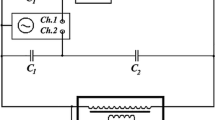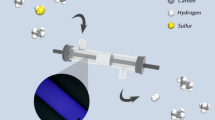Abstract
The increasing usage of the feed gases of lower grade liquid oxygen (LOX) containing higher levels of trace hydrocarbon impurities in dielectric barrier discharge (DBD) for ozone generation requires a better understanding of the kinetics of the by-product formation resulting from reactions involving these hydrocarbon impurities. As a case study of hydrocarbon impurities, the kinetics of CH4 conversion in DBDs and the subsequent HNO3 formation were investigated by means of gas-phase plasma diagnostics, supported by detailed process modeling, and extensive in-situ and ex-situ by-product analysis. The by-products formation in the plasma with the presence of CH4, were found to differ significantly in oxygen-fed generators as compared to generators fed with oxygen/nitrogen mixtures. The amount of HNO3 formed depends on the concentration of NO x formed in the plasma and the amount of CH4 that is converted, but not on the O3 concentration. In the present work we have investigated CH4 concentrations of up to 1.95 wt% of the feed gas. The rate of deterioration of the overall ozone generator performance was found to be affected by the concentration of nitrogen in the oxygen/nitrogen mixture.
Similar content being viewed by others
References
U. Kogelschatz, J. Müller, Brown Boveri Corporate Research, Baden, Technical Report KLR 85-50 B, 1985
U. Kogelschatz, P. Baessler, Ozone Sci. Eng. 9, 195 (1987)
Series in Plasma Physics: Non-Equilibrium Air Plasmas at Atmospheric Pressure, edited by K.H. Becker, U. Kogelschatz, K.H. Schoenbach, R.J. Barker (Institute of Physics Publishing Ltd., Bristol and Philadelphia, 2005)
U. Kogelschatz, B. Eliasson, M. Hirth, Ozone Sci. Eng. 10, 367 (1988)
W.E. Cromwell, T.C. Manley, Adv. Chem. Ser. 21, 304 (1959)
E. Inoue, K. Sugino, Adv. Chem. Ser. 21, 313 (1959)
M. Salvermoser, D.E. Murnick, U. Kogelschatz, Sci. Eng. 30, 228 (2008)
M. Salvermoser, D.E. Murnick, U. Kogelschatz, Eur. Phys. J. Appl. Phys. 47, 22812 (2009)
M. Figus, Master’s Thesis, Stevens Institute of Technology, 2004
B. Eliasson, J. Müller, Brown Boveri Corporate Research, Baden, Technical Report KLR 79-31 B, 1979
L.C. Pitchford, E. Sciamma, Ozonia Ltd., Dübendorf, Technical Report HKH108665, 2005
G. Vezzù, Ozonia AG, Dübendorf, Technical Report HKH 107695 LPC, 2006
G. Vezzù, R. Merz, R. Gisler, M. Müller, B. Paolini, J.L. Lopez, A. Freilich, K.H. Becker, in Proceedings of IOA, 17th Ozone World Congress, Los Angeles, CA, USA, 2007
G. Vezzù, J.L. Lopez, A. Freilich, K.H. Becker, IEEE Trans. Plasma Sci. 37, 890 (2009)
H.V. Lang, Ozonia AG, Dübendorf, Technical Report HKH105573, 2003
Author information
Authors and Affiliations
Corresponding author
Rights and permissions
About this article
Cite this article
Lopez, J.L., Vezzu, G., Freilich, A. et al. Effects of hydrocarbon contamination on ozone generation with dielectric barrier discharges. Eur. Phys. J. D 67, 180 (2013). https://doi.org/10.1140/epjd/e2013-40126-2
Received:
Revised:
Published:
DOI: https://doi.org/10.1140/epjd/e2013-40126-2




